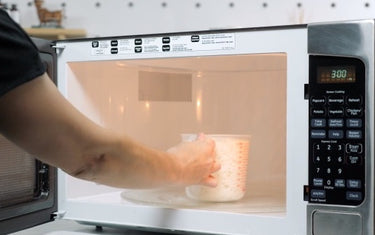5 min read / 2 January 2024 / yasmin sharp
Coconut Candles: The Pros and Cons
Explore the pros and cons of coconut wax candles, focusing on their environmental impact, burning efficiency, and unique characteristics in our detailed blog.
Share this post

There are lots of reasons to love coconut wax candles, and they are a favourite with many people who prefer an eco-friendly wax that produces a slow burn with a strong scent throw.
Coconut wax is also a natural option for anyone who is concerned about harmful toxins being released in their home.
To give you a balanced perspective, we look at the pros and cons of coconut wax candles, so you can decide if they are suitable for your lifestyle.
What are coconut wax candles?Coconut wax candles are candles that are made from colourless, odourless coconut oil that has been extracted from a coconut. They can also be blended with harder, natural waxes such as paraffin, soy or beeswax, which helps to create a long-lasting candle. |

What are the pros of coconut wax candles?
Some of the main benefits of coconut wax candles include:
They are very eco friendly
Coconut wax candles are often considered to be one of the most eco-friendly, especially when compared to soy or paraffin-based candles.
This is because they produce a cleaner, soot-free burn that does not release any harmful toxins or damage surfaces they are burnt on.
The sustainability factor is also an important part of the candle’s appeal.
Because they are made from organic, renewable materials their environmental impact is minimal.
They are also biodegradable, which means they will naturally decompose when the remnants are disposed of.
No links to deforestation
If the environmental aspect is something you are keen to focus on, there is another eco-friendly benefit that could convince you these are the right candles for you.
Whilst many other wax types, such as palm wax and paraffin wax, require mass production that can lead to deforestation, this is not an issue with coconut wax.
Coconut wax is taken from coconuts grown on coconut trees, which can survive for up to 80 years.
Because they grow naturally, they are not sprayed with pesticides and are completely renewable, ensuring that the wax you use is sustainable.
Slow burn time
Another benefit of using coconut wax for candle making is that they are slow burning, making it a more cost-effective option.
So, not only does the candle last for longer, but they can retain scents and aromas, allowing you to get more from the fragrance.
If you have the funds to invest in a larger candle, this will probably be the better option, as it means the burn time will be extended.
Strong scent throw
In addition to coconut wax candles providing a longer burn time, they can also produce better scent throws.
This helps to push the fragrance around your home more efficiently, so once the candle has been ignited, the space will quickly be filled with the natural properties provided by the essential oil.
Alternatively, when making a candle from scratch, you could try mixing coconut wax with beeswax, as this produces a sweet aroma that is both healthy and relaxing.

What are the cons of coconut wax candles?
The main disadvantages of using coconut wax candles is that they have a:
Low melting point
When talking about the melting point, this refers to the temperature at which the wax will start to naturally be affected by its environment.
When it comes to coconut wax candles, one issue to be aware of is that they have a lower melting point if they are not blended with another natural wax.
This is the main reason why coconut wax is often blended with soy or beeswax, as it helps to create a more stable candle that does not melt as easily.
Limited variety of candle types
The melting point issue also means that there is a limited variety of pure coconut wax candles to choose from, in terms of shape and size.
If you want to buy coconut wax candles that have not been blended with beeswax, paraffin or soy wax, you will likely find that your buying options are more limited compared to other types of candles.
Higher manufacturing costs
Compared to some wax types – paraffin, for example – the production costs for making coconut wax candles tend to be higher.
Because the wax is a pure substance it is more expensive to produce and if it is being blended with other waxes then this can add additional costs.
For consumers, this means the retail price can be higher – although when you take all of the benefits into account, you may find paying a little extra is worth it in the long run.
What is the best way to make candles with coconut wax?
When it comes to using coconut wax for candle making, keep in mind the following:
- Allow the wax to cure for up to 7 days, if possible. This allows the essential oil or fragrance oil to settle into the wax to enhance and strengthen the scent throw.
- When planning the candle size, think about the size of the room it will be burnt in. Smaller spaces require smaller candles, whilst larger rooms will benefit from having a larger candle that can create the right ambience.
- Cotton or wooden wicks tend to best, as they produce a longer, consistent burn and also look better aesthetically.
- Keep an eye on the room temperature when the candle is lit, as this can also impact the melting point, especially if it is a pure coconut wax candle.
- When lighting the candle for the first time, leave it to burn for about 3 hours. A good rule of thumb to follow is to let it burn for at least one hour per inch of the container diameter, as this helps to prevent tunnelling.

From their sustainability and all-round environmentally friendly appeal to the slow burn time and strong scent throwing capabilities, there are a lot of pluses to using coconut wax candles.
However, it is worth bearing in mind that they do have a low melting point and may be priced a little higher due to the manufacturing costs.
Every type of wax has its pros and cons, so it’s about finding what works best for you, and if the benefits of coconut wax outweigh the disadvantages, it could be just what you are looking for.









